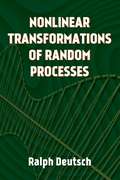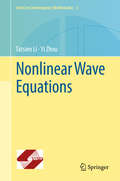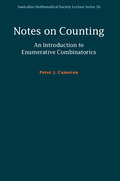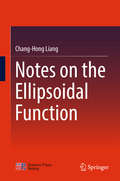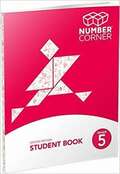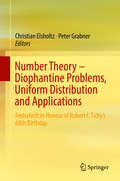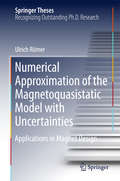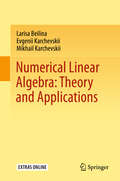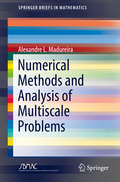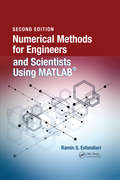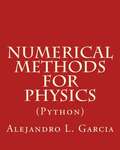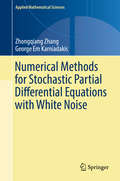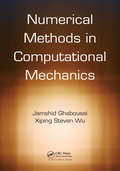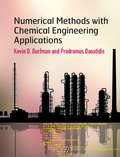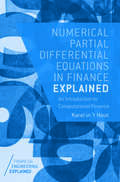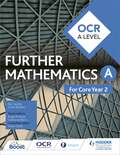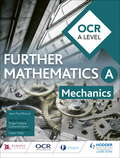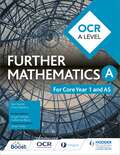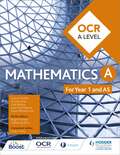- Table View
- List View
Nonlinear Transformations of Random Processes (Dover Books on Electrical Engineering)
by Ralph DeutschThis concise treatment of nonlinear noise techniques encountered in system applications is suitable for advanced undergraduates and graduate students. The book is also a valuable reference for systems analysts and communication engineers, as it discusses the basic mathematical theories of nonlinear transformations applied to random processes encountered in communications and control systems. Prerequisites include a familiarity with statistics, probability, complex variables, and Fourier and Laplace transforms. The first five chapters present specific classes of nonlinear devices and random processes that in combination lead to closed form solutions for the statistical properties of the transformed process. Subsequent chapters address techniques based on the use of series representations, general systematic approaches to the subject of nonlinear transformations of random processes, and sampling and quantizing a random process. A helpful Appendix features notes on hypergeometric functions.
Nonlinear Wave Equations
by Tatsien Li Yi ZhouThis book focuses on nonlinear wave equations, which are of considerable significance from both physical and theoretical perspectives. It also presents complete results on the lower bound estimates of lifespan (including the global existence), which are established for classical solutions to the Cauchy problem of nonlinear wave equations with small initial data in all possible space dimensions and with all possible integer powers of nonlinear terms. Further, the book proposes the global iteration method, which offers a unified and straightforward approach for treating these kinds of problems. Purely based on the properties of solut ions to the corresponding linear problems, the method simply applies the contraction mapping principle.
Notes on Counting: An Introduction to Enumerative Combinatorics (Australian Mathematical Society Lecture Series #26)
by Peter J. CameronEnumerative combinatorics, in its algebraic and analytic forms, is vital to many areas of mathematics, from model theory to statistical mechanics. This book, which stems from many years' experience of teaching, invites students into the subject and prepares them for more advanced texts. It is suitable as a class text or for individual study. The author provides proofs for many of the theorems to show the range of techniques available, and uses examples to link enumerative combinatorics to other areas of study. The main section of the book introduces the key tools of the subject (generating functions and recurrence relations), which are then used to study the most important combinatorial objects, namely subsets, partitions, and permutations of a set. Later chapters deal with more specialised topics, including permanents, SDRs, group actions and the Redfield-P#65533;lya theory of cycle indices, M#65533;bius inversion, the Tutte polynomial, and species.
Notes on the Ellipsoidal Function
by Chang-Hong LiangThis book focuses on the ellipsoidal function, which serves as an evolution and extension of the circular function (trigonometric function) and elliptic function. It presents an in-depth discussion of the ellipsoidal function (algebra) theory and the conformal mapping (geometry) theory of the ellipsoid function, demonstrating the outstanding performance of the ellipsoid function response filter. Applications of the ellipsoidal function include the capacitance of ellipsoidal conductors and the surface area of ellipsoids, which in turn correspond to ellipsoidal integrals of the first kind and the second kind, respectively. The book offers a valuable reference guide for undergraduates, graduate students and researchers in the related fields.
Number Corner Second Edition Grade 5 Student Book
by The Math Learning CenterA mathematics textbook
Number Corner, Grade 2, Student Book, Spanish Edition
by The Math Learning CenterNIMAC-sourced textbook
Number Corner: Student Book
by Math Learning CenterThe Number Corner 2nd Edition Grade 3 Student Book provides students with opportunities to solve problems, conduct investigations, and practice skills in the context of familiar Number Corner Grade 3 lessons.
Number Theory – Diophantine Problems, Uniform Distribution and Applications
by Christian Elsholtz Peter GrabnerThis volume is dedicated to Robert F. Tichy on the occasion of his 60th birthday. Presenting 22 research and survey papers written by leading experts in their respective fields, it focuses on areas that align with Tichy's research interests and which he significantly shaped, including Diophantine problems, asymptotic counting, uniform distribution and discrepancy of sequences (in theory and application), dynamical systems, prime numbers, and actuarial mathematics. Offering valuable insights into recent developments in these areas, the book will be of interest to researchers and graduate students engaged in number theory and its applications.
Numbers and Computers
by Ronald T. KneuselThis is a book about numbers and how those numbers are represented in and operated on by computers. It is crucial that developers understand this area because the numerical operations allowed by computers, and the limitations of those operations, especially in the area of floating point math, affect virtually everything people try to do with computers. This book aims to fill this gap by exploring, in sufficient but not overwhelming detail, just what it is that computers do with numbers. Divided into two parts, the first deals with standard representations of integers and floating point numbers, while the second examines several other number representations. Details are explained thoroughly, with clarity and specificity. Each chapter ends with a summary, recommendations, carefully selected references, and exercises to review the key points. Topics covered include interval arithmetic, fixed-point numbers, big integers and rational arithmetic. This new edition has three new chapters: Pitfalls of Floating-Point Numbers (and How to Avoid Them), Arbitrary Precision Floating Point, and Other Number Systems. This book is for anyone who develops software including software engineers, scientists, computer science students, engineering students and anyone who programs for fun.
Numerical Approximation of the Magnetoquasistatic Model with Uncertainties
by Ulrich RömerThis book presents a comprehensive mathematical approach for solving stochastic magnetic field problems. It discusses variability in material properties and geometry, with an emphasis on the preservation of structural physical and mathematical properties. It especially addresses uncertainties in the computer simulation of magnetic fields originating from the manufacturing process. Uncertainties are quantified by approximating a stochastic reformulation of the governing partial differential equation, demonstrating how statistics of physical quantities of interest, such as Fourier harmonics in accelerator magnets, can be used to achieve robust designs. The book covers a number of key methods and results such as: a stochastic model of the geometry and material properties of magnetic devices based on measurement data; a detailed description of numerical algorithms based on sensitivities or on a higher-order collocation; an analysis of convergence and efficiency; and the application of the developed model and algorithms to uncertainty quantification in the complex magnet systems used in particle accelerators.
Numerical Linear Algebra: Theory and Applications
by Larisa Beilina Evgenii Karchevskii Mikhail KarchevskiiThis book combines a solid theoretical background in linear algebra with practical algorithms for numerical solution of linear algebra problems. Developed from a num- ber of courses taught repeatedly by the authors, the material covers topics like matrix algebra, theory for linear systems of equations, spectral theory, vector and matrix norms combined with main direct and iterative numerical methods, least squares problems, and eigenproblems. Numerical algorithms illustrated by computer programs written in MATLAB#65533; are also provided as supplementary material on SpringerLink to give the reader a better understanding of professional numerical software for the solution of real-life problems. Perfect for a one- or two-semester course on numerical linear algebra, matrix computation, and large sparse matrices, this text will interest students at the advanced undergraduate or graduate level.
Numerical Methods and Analysis of Multiscale Problems
by Alexandre L. MadureiraThis book is about numerical modeling of multiscale problems, and introduces several asymptotic analysis and numerical techniques which are necessary for a proper approximation of equations that depend on different physical scales. Aimed at advanced undergraduate and graduate students in mathematics, engineering and physics - or researchers seeking a no-nonsense approach -, it discusses examples in their simplest possible settings, removing mathematical hurdles that might hinder a clear understanding of the methods. The problems considered are given by singular perturbed reaction advection diffusion equations in one and two-dimensional domains, partial differential equations in domains with rough boundaries, and equations with oscillatory coefficients. This work shows how asymptotic analysis can be used to develop and analyze models and numerical methods that are robust and work well for a wide range of parameters.
Numerical Methods for Engineers and Scientists Using MATLAB®
by Ramin S. EsfandiariThis book provides a pragmatic, methodical and easy-to-follow presentation of numerical methods and their effective implementation using MATLAB, which is introduced at the outset. The author introduces techniques for solving equations of a single variable and systems of equations, followed by curve fitting and interpolation of data. The book also provides detailed coverage of numerical differentiation and integration, as well as numerical solutions of initial-value and boundary-value problems. The author then presents the numerical solution of the matrix eigenvalue problem, which entails approximation of a few or all eigenvalues of a matrix. The last chapter is devoted to numerical solutions of partial differential equations that arise in engineering and science. Each method is accompanied by at least one fully worked-out example showing essential details involved in preliminary hand calculations, as well as computations in MATLAB. This thoroughly-researched resource:
Numerical Methods for Physics (Python)
by Alejandro L. GarciaThis book covers a broad spectrum of the most important, basic numerical and analytical techniques used in physics —including ordinary and partial differential equations, linear algebra, Fourier transforms, integration, and probability. This version of the text uses Python with Matlab, C++, and FORTRAN versions of the programs also available on-line.
Numerical Methods for Stochastic Partial Differential Equations with White Noise
by George Em Karniadakis Zhongqiang ZhangThis book covers numerical methods for stochastic partial differential equations with white noise using the framework of Wong-Zakai approximation. The book begins with some motivational and background material in the introductory chapters and is divided into three parts. Part I covers numerical stochastic ordinary differential equations. Here the authors start with numerical methods for SDEs with delay using the Wong-Zakai approximation and finite difference in time. Part II covers temporal white noise. Here the authors consider SPDEs as PDEs driven by white noise, where discretization of white noise (Brownian motion) leads to PDEs with smooth noise, which can then be treated by numerical methods for PDEs. In this part, recursive algorithms based on Wiener chaos expansion and stochastic collocation methods are presented for linear stochastic advection-diffusion-reaction equations. In addition, stochastic Euler equations are exploited as an application of stochastic collocation methods, where a numerical comparison with other integration methods in random space is made. Part III covers spatial white noise. Here the authors discuss numerical methods for nonlinear elliptic equations as well as other equations with additive noise. Numerical methods for SPDEs with multiplicative noise are also discussed using the Wiener chaos expansion method. In addition, some SPDEs driven by non-Gaussian white noise are discussed and some model reduction methods (based on Wick-Malliavin calculus) are presented for generalized polynomial chaos expansion methods. Powerful techniques are provided for solving stochastic partial differential equations. This book can be considered as self-contained. Necessary background knowledge is presented in the appendices. Basic knowledge of probability theory and stochastic calculus is presented in Appendix A. In Appendix B some semi-analytical methods for SPDEs are presented. In Appendix C an introduction to Gauss quadrature is provided. In Appendix D, all the conclusions which are needed for proofs are presented, and in Appendix E a method to compute the convergence rate empirically is included. In addition, the authors provide a thorough review of the topics, both theoretical and computational exercises in the book with practical discussion of the effectiveness of the methods. Supporting Matlab files are made available to help illustrate some of the concepts further. Bibliographic notes are included at the end of each chapter. This book serves as a reference for graduate students and researchers in the mathematical sciences who would like to understand state-of-the-art numerical methods for stochastic partial differential equations with white noise.
Numerical Methods in Computational Mechanics
by Jamshid Ghaboussi Xiping Steven WuThis book explores the numerical algorithms underpinning modern finite element based computational mechanics software. It covers all the major numerical methods that are used in computational mechanics. It reviews the basic concepts in linear algebra and advanced matrix theory, before covering solution of systems of equations, symmetric eigenvalue solution methods, and direct integration of discrete dynamic equations of motion, illustrated with numerical examples. This book suits a graduate course in mechanics based disciplines, and will help software developers in computational mechanics. Increased understanding of the underlying numerical methods will also help practicing engineers to use the computational mechanics software more effectively.
Numerical Methods with Chemical Engineering Applications
by Prodromos Daoutidis Kevin D. DorfmanDesigned primarily for undergraduates, but also graduates and practitioners, this textbook integrates numerical methods and programming with applications from chemical engineering. Combining mathematical rigor with an informal writing style, it thoroughly introduces the theory underlying numerical methods, its translation into MATLAB programs, and its use for solving realistic problems. Specific topics covered include accuracy, convergence and numerical stability, as well as stiffness and ill-conditioning. MATLAB codes are developed from scratch, and their implementation is explained in detail, all while assuming limited programming knowledge. All scripts employed are downloadable, and built-in MATLAB functions are discussed and contextualised. Numerous examples and homework problems - from simple questions to extended case studies - accompany the text, allowing students to develop a deep appreciation for the range of real chemical engineering problems that can be solved using numerical methods. This is the ideal resource for a single-semester course on numerical methods, as well as other chemical engineering courses taught over multiple semesters.
Numerical Partial Differential Equations in Finance Explained
by Karel in 't HoutThis book provides a first, basic introduction into the valuation of financial options via the numerical solution of partial differential equations (PDEs). It provides readers with an easily accessible text explaining main concepts, models, methods and results that arise in this approach. In keeping with the series style, emphasis is placed on intuition as opposed to full rigor, and a relatively basic understanding of mathematics is sufficient. The book provides a wealth of examples, and ample numerical experiments are givento illustrate the theory. The main focus is on one-dimensional financial PDEs, notably the Black-Scholes equation. The book concludes with a detailed discussion of the important step towards two-dimensional PDEs in finance.
OCR A Level Further Mathematics Core Year 2
by Ben Sparks Claire BaldwinExam Board: OCRLevel: A-levelSubject: MathematicsFirst Teaching: September 2017First Exam: June 2018An OCR endorsed textbookGrow your students' confidence in applying mathematical techniques to solving problems with resources developed specifically for the OCR specification subject experts and in conjunction with MEI (Mathematics in Education and Industry).- Develop reasoning and problem-solving skills with practice questions and differentiated exercises that build mathematical techniques.- Help students to overcome misconceptions and develop insight into problem-solving with annotated worked examples.- Build connections between topics with points of interest and things to notice such as links to real world examples and noticing patterns in the mathematics.- Enhance individual understanding with discussion points designed for the classroom.- Consolidate understanding with end of chapter summaries of the key points.- Provide clear paths of progression that combine pure and applied maths into a coherent whole.- Reinforce Year 1 content with short review chapters - Year 2 only
OCR A Level Further Mathematics Mechanics
by Jean-Paul MuscatGrow your students' confidence in applying mathematical techniques to solving problems with resources developed specifically for the OCR specification by subject specialists and MEI (Mathematics in Education and Industry).- Develop reasoning and problem-solving skills with practice questions and differentiated exercises that build mathematical techniques.- Help students to overcome misconceptions and develop insight into problem-solving with annotated worked examples.- Build connections between topics with points of interest and things to notice such as links to real world examples and noticing patterns in the mathematics.- Enhance individual understanding with discussion points designed for the classroom.- Consolidate understanding with end of chapter summaries of the key points.
OCR A Level Further Mathematics Year 1 (AS): For Core Year 1 And As
by Ben Sparks Claire BaldwinGrow your students' confidence in applying mathematical techniques to solving problems with resources developed specifically for the OCR specification subject experts and in conjunction with MEI (Mathematics in Education and Industry).- Develop reasoning and problem-solving skills with practice questions and differentiated exercises that build mathematical techniques.- Help students to overcome misconceptions and develop insight into problem-solving with annotated worked examples.- Build connections between topics with points of interest and things to notice such as links to real world examples and noticing patterns in the mathematics.- Enhance individual understanding with discussion points designed for the classroom.- Consolidate understanding with end of chapter summaries of the key points.- Provide clear paths of progression that combine pure and applied maths into a coherent whole.
OCR A Level Mathematics Year 1 (AS)
by Val Hanrahan Sophie Goldie Cath Moore Jean-Paul Muscat Susan WhitehouseBoost your students' knowledge, skills and understanding so that they can reason and apply mathematical techniques in solving problems; with resources developed specifically for the OCR specification by subject experts and in conjunction with MEI (Mathematics in Education and Industry).- Boosts students' confidence approaching assessment with plenty of practice questions and skill-focused exercises.- Build connections between topics with points of interest and things to notice such as links to real world examples and noticing patterns in the mathematics. - Ensure targeted development of problem-solving, proof and modelling with dedicated sections on these key areas.- Help students to overcome misconceptions and develop insight into problem-solving with annotated worked examples.- Enhance individual understanding with discussion points designed for the classroom and end of chapter summaries of the key points.- Tackle the new statistics requirements with five dedicated statistics chapters and questions around the use of large data sets. - Address the use of technology in Mathematics with a variety of questions based around the use of spreadsheets, graphing software and graphing calculators. - Provide clear paths of progression that combine pure and applied maths into a coherent whole.
ORIGO Stepping Stones 2.0, Comprehensive Mathematics [Grade 2], Student Book A
by James Burnett Calvin Irons Peter StowasserNIMAC-sourced textbook
